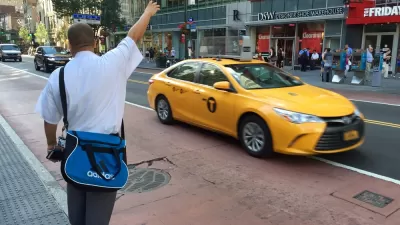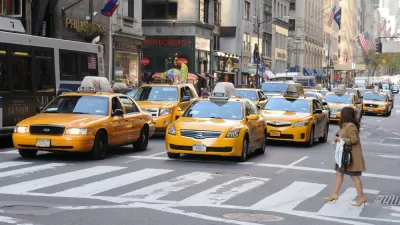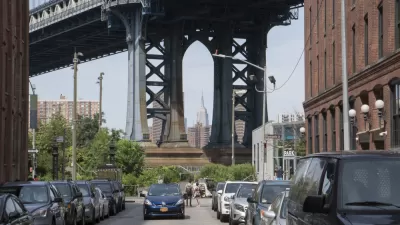To support the taxi industry and reduce congestion, the New York City Council could cap the number of ride-hailing vehicles operating in the city. The cap could be a first major step toward a new era of transportation regulation.

"New York City officials are moving to cap the number of vehicles driving for Uber and other ride-hailing services as part of an aggressive move to address mounting concerns that their explosive growth has led to worsening congestion and low driver wages," reports Emma G. Fitzsimmons.
If the proposed legislation is approved by the New York City Council, it would be the first city in the United States to set a limit on ride-hailing vehicles, according to Fitzsimmons. "Mayor Bill de Blasio, while stopping short of fully endorsing the proposal, suggested that the time had come to rein in the industry," but the mayor also supported a cap, which eventually failed, in 2015. City Council Speaker Corey Johnson proposed the current cap.
Fitzsimmons presents the news of the proposed cap on the number of ride-hailing vehicles in context of the rapid transformation that transportation network companies have had on transportation. That transformation had had significant consequences—for the taxi industry, for congestion, and on the infiltration of mobile app technology into every aspect of daily life.
Andrew J. Hawkins provides coverage of the story for The Verge, and Reuters also reported the news, reflecting the importance of the development for New York, but also for the ongoing, big questions about how cities will regulate transportation in an era of innovation that already includes dockless bikes and electric scooters, and could one day could also include self-driving cars. So far, some cities have proven willing to regulate the number of dockless bikes and to regulate the use of electric scooters, but transportation network companies and companies testing autonomous vehicles have leveraged their industry might (or their popularity with the public) to avoid significant regulation.
FULL STORY: New York Could Become First Major U.S. City to Cap Uber and Similar Vehicles

Maui's Vacation Rental Debate Turns Ugly
Verbal attacks, misinformation campaigns and fistfights plague a high-stakes debate to convert thousands of vacation rentals into long-term housing.

Planetizen Federal Action Tracker
A weekly monitor of how Trump’s orders and actions are impacting planners and planning in America.

In Urban Planning, AI Prompting Could be the New Design Thinking
Creativity has long been key to great urban design. What if we see AI as our new creative partner?

King County Supportive Housing Program Offers Hope for Unhoused Residents
The county is taking a ‘Housing First’ approach that prioritizes getting people into housing, then offering wraparound supportive services.

Researchers Use AI to Get Clearer Picture of US Housing
Analysts are using artificial intelligence to supercharge their research by allowing them to comb through data faster. Though these AI tools can be error prone, they save time and housing researchers are optimistic about the future.

Making Shared Micromobility More Inclusive
Cities and shared mobility system operators can do more to include people with disabilities in planning and operations, per a new report.
Urban Design for Planners 1: Software Tools
This six-course series explores essential urban design concepts using open source software and equips planners with the tools they need to participate fully in the urban design process.
Planning for Universal Design
Learn the tools for implementing Universal Design in planning regulations.
planning NEXT
Appalachian Highlands Housing Partners
Mpact (founded as Rail~Volution)
City of Camden Redevelopment Agency
City of Astoria
City of Portland
City of Laramie





























